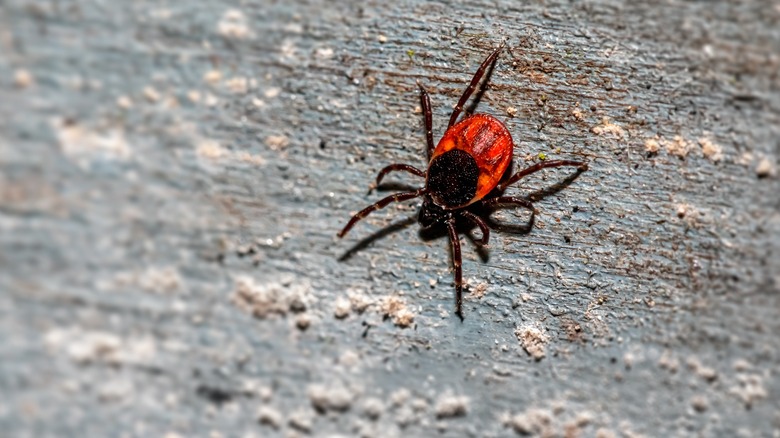The Unexpected Bladder Problem Caused By Lyme Disease
Lyme disease is a bacterial illness caused by the bite of an infected tick, which carries a host of unpleasant symptoms (via MedlinePlus). These symptoms include a red rash, fever, headache, fatigue, and muscle and joint aches. In extreme cases, when left untreated, Lyme disease can lead to facial palsy, arthritis in your knees and joints, and inflammation of the brain and spinal cord.
According to the Centers for Disease Control and Prevention (CDC), the symptoms of Lyme disease are typically caused by the bacterium Borrelia burgdorferi, which is carried by black-legged ticks. In most cases, the first sign of an infection is a red rash, called an Erythema migrans rash (via the CDC), which can occur anywhere from three to 30 days after an infected tick bite. Usually, if treatment begins soon, with either oral or intravenous antibiotics, Lyme disease should clear up (via the Mayo Clinic). In some cases, symptoms, such as muscle aches and fatigue, may linger. In addition, there can be even more insidious side effects that come from Lyme disease, including issues with your bladder.
Lyme disease can spring up in unexpected places
In some cases of Lyme disease, the patient can show symptoms that mimic those of a bladder infection (via Treat Lyme). These include the urge to urinate, bladder pain, cramping, and an increased frequency of urination. In these cases, the patient is not suffering from a bladder infection, but from a condition called interstitial cystitis.
According to a 2000 study published in European Urology, the bacteria Borrelia burgdorferi was known to be found in bladder biopsies and the urine of Lyme disease patients. Additionally, bartonella, another bacteria associated with Lyme disease, can irritate the bladder and lead to interstitial cystitis and other inflammatory urological conditions (via Lymedisease.org). A microbe called mycoplasma, which is a common source of bladder discomfort, can be found in approximately 75% of Lyme disease patients, as per RawlsMD. Mycoplasma is small bacteria that tends to exist in the lining of the body, which stands to reason that it would end up in the bladders of Lyme disease patients, leading to interstitial cystitis.
Treatment isn't always simple
Unfortunately, treatment for interstitial cystitis is not straightforward, and there is no universal treatment for the condition (via the Mayo Clinic). If you're suffering from interstitial cystitis, you may have to look for a combination of treatments before you land on the one that best treats your specific symptoms. These can include physical therapy to relieve pelvic pain, ibuprofen, antihistamines, and tricyclic antidepressants. There is also a drug called Elmiron, which has been approved by the Food and Drug Administration specifically to treat interstitial cystitis.
You can also try some lifestyle changes, such as managing stress, altering your diet, and retraining your bladder to hold urine longer (via WebMD). For cases of interstitial cystitis related to Lyme disease, you can try prescription antibiotics or a herbal combination of L-arginine, Quercetin, and Glucosamine HCL three times a day (via Treat Lyme). Before you undertake any treatment, either for Lyme disease or interstitial cystitis, consult your doctor to ensure you get the correct diagnosis.



